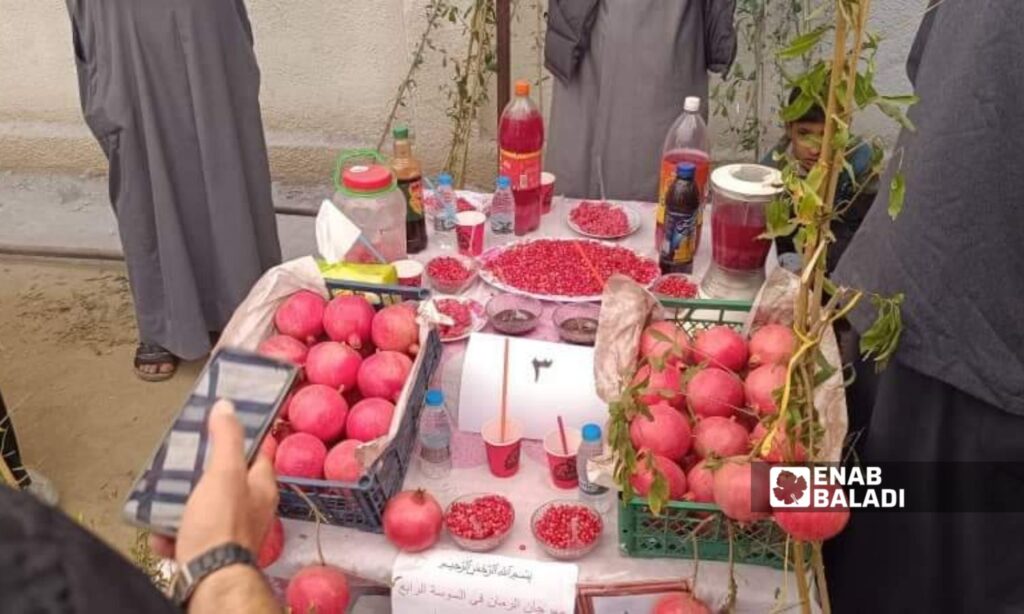Deir Ezzor – Obadah al-Sheikh
The harvest of pomegranate crops in the rural areas of eastern Deir Ezzor, Syria, began in early October, with expectations of good returns and a plentiful season that compensates for the losses of 2023.
Pomegranates are one of the widely cultivated crops, especially in the Sousa area, grown in homes and farms. Towns such as al-Shafah, al-Arqoub, al-Bubadran, and al-Baghouz are some of the villages famous for their cultivation.
In addition to farmers waiting for the season to achieve a profit margin, the gathering of pomegranates provides job opportunities for many families in the area, amid a scarcity of work, as most residents rely on agriculture as their primary source of income.
Good yield
Abdul Hamid al-Jadi’a, a pomegranate orchard owner in the city of Sousa, stated that this year’s production is good and compensates for farmers’ losses from 2023, saying that the yield per dunum ranges between two and three tons of pomegranates.
He told Enab Baladi that a farmer incurs approximately 400 US dollars (6 million Syrian pounds) until the time of pomegranate harvesting, covering plowing, watering, and fertilizers for each dunum.
The price per ton of pomegranates reaches 350 US dollars, and the farmers sell them in the local market or to traders who ship them to other provinces and areas.
Al-Jadi’a, who is also an assistant engineer, mentioned that pomegranates from the city of Sousa are distinguished by their large size, sweet taste, and red color. The Sousa area includes al-Shafah, al-Arqoub, al-Bubadran, and al-Baghouz, with about 140,000 pomegranate trees.
Pomegranates are considered a strategic crop in that region, and residents depend on them as a source of income and for storage, extracting juice and molasses from them, and selling them in the local market.
Khaled al-Zayeen, another farmer from the Sousa area, told Enab Baladi that this year’s pomegranate crop is abundant on his land and has achieved “good” profits, as he owns ten dunums, with a yield of three tons per dunum, compensating for his losses from last year.
Job opportunities
The pomegranate season has created job opportunities for many families, and wages for workers have increased due to the abundance of the crop.
Rahaf al-Ahmad works around five hours a day in harvesting pomegranates and earns about 50,000 Syrian pounds (3 US dollars), saying she waits for the season to assist her husband, who also works in agriculture as a daily laborer, doing tasks such as plowing, watering, and harvesting.
Another worker, Abdul Rahman al-Rajab, said that he works with his three sons and two daughters in a labor workshop, earning about 250,000 Syrian pounds with his family.
He mentioned that the amount is sufficient for the family’s needs, noting that orchard owners sometimes reward workers with some pomegranates as bonuses.
Before the season, daily wages for workers ranged between 20,000 and 30,000 Syrian pounds.
Losses of 2023 season
The 2023 season was a loss for most pomegranate farmers, as they were unable to export their crops to areas under Syrian regime’s control due to road closures and border crossings, with sales confined to local markets such as Raqqa and al-Hasakah.
Farmers had no ability to bear the exorbitant costs of marketing to farther areas, amid a lack of support for farmers and the unavailability of fertilizers, pesticides, packaging materials, and others in the markets.
Iraq was previously the main route for exporting pomegranates, but on October 21, 2020, the Iraqi Ministry of Agriculture decided to ban the import of pomegranates due to local abundance, according to the Iraqi News Agency (INA).
The annual pomegranate festival is held in the city of Sousa, where farmers participate to showcase their products and sell items such as fruits, molasses, and vinegar. The fourth annual festival took place on October 27.
The agricultural sector in northeastern Syria suffers from weak support and limited ability to export crops outside the region, forcing farmers in past years to sell at prices that do not correspond with costs.
Crop yields in the area have been affected by the battles that occurred between the Syrian Democratic Forces (SDF) and the Islamic State group, and the closure of official river crossings between areas under regime government control and areas controlled by the SDF.

